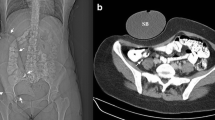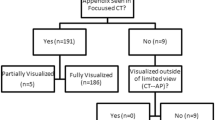Abstract
Purpose: The purpose of this study is to determine if focused CT examinations of the pelvis, utilizing fixed oral dosage of diatrizoate contrast media, improve overall reader confidence in visualization of the appendix. Materials and methods: Five hundred and twenty-five patients referred for, rule out appendicitis, evaluations underwent focused CT examinations of the pelvis following fixed oral dosage of diatrizoate contrast media. A five-point scale was used to assess the effect of contrast enhancement of the distal small bowel, cecum, and appendix on overall reader confidence, and subsequent visualization of the appendix. Results: Bowel preparation was ideal in 504 of 525 (96%) patients. Enhanced supine CT images following oral administration of fixed dosage of diatrizoate had consistently good scores for reader confidence for bowel opacification (4.8±0.1, P<0.005) and visualization of the appendix (3.7±0.1, P<0.005), at 50 min following oral contrast administration. This method improved visualization of the normal appendix in 446 of 504 (88%) patients, with a specificity of 99%. In a patients meeting CT criteria for appendicitis, 21 of 21 (100%) patients were proven at surgery. Conclusion: The use of fixed oral dosage of diatrizoate contrast media resulted in good overall reader confidence to visualize the appendix and peri-appendiceal area, in addition to high specificity and rapid transit time.




Similar content being viewed by others
References
Rypins EB, Kipper SL (2000) Scintigraphic determination of equivocal appendicitis. Am Surg 66:891–895
Rypins EB, Kipper SL, Weiland F (2002) 99 m Tc anti-CD 15 monoclonal antibody (LeuTech) imaging improves diagnostic accuracy and clinical management in patients with equivocal presentation of appendicitis. Ann Surg 235:232–239
Rao PM, Rhea JT, Novelline RA (1998) Effect of computed tomography of the appendix on treatment of patients and use of hospital resources. N Engl J Med 338:141–146
Mullins ME, Kircher MF, Ryan DP (2001) Evaluation of suspected appendicitis in children using limited helical CT and colonic contrast material. Am J Roentgenol 176:37–41
Raptopoulos V, Katsou G, Rosen MP (2003) Acute appendicitis: effect of increased use of CT on selecting patients earlier. Radiology 226:521–526
Callahan MJ, Rodriguez DP, Taylor GA (2002) CT of appendicitis in children. Radiology 224:325–332
Kapote S, Nazareth HM, Bapat RD (1988) Barium peritonitis: a case report. J Postgrad Med 34:103–104
Karanikas ID, Kaloulidis DD, Gouvas ZT (1997) Barium peritonitis: a rare complication of upper gastrointestinal contrast investigation. Postgrad Med J 73:297–298
Giuliano V, Giuliano C, Pinto F (2004) Rapid CT visualization of the appendix and early acute non-perforated appendicitis using an improved oral contrast method. Emerg Radiol 10:235–237
Morrin M, Farrel R, Kruskal J (2000) Utility of intravenously administered contrast material at CT colonography. Radiology 217:765–771
Sivit CJ (2004) Controversies in emergency radiology: acute appendicitis in children—the case for CT. Emerg Radiol 10:238–240
Angelescu N (2001) The useless appendectomy. Chirurgia Bucur 96:265–268
Andren-Sandberg A, Ryska M (2004) Exploratory laparotomy at suspicion of acute appendicitis. Rozhl Chir 83:131–137
Kosloske A, Love C, Rohrer J (2004) The diagnosis of appendicitis in children: outcomes of a strategy based on pediatric surgical evaluation. Pediatrics 113:29–34
Panjanen H, Julkunen K, Waris H (2005) Laparoscopy in chronic abdominal pain: a prospective nonrandomized long-term follow-up. J Clin Gastroenterol 39:110–114
Courtney E, Melville D, Leicester R (2003) Chronic appendicitis diagnosed incidentally by colonoscopy. Hosp Med 64:434–435
Line B, Breyer R, McElvany K (2004) Evaluation of human anti-mouse antibody response in normal volunteers following repeated injections of fanolesomab (NeuroSpec), a murine anti-CD15 IgM monoclonal antibody for injection. Nucl Med Commun 25:807–811
DeArmond G, Dent D, Myers J (2003) Appendicitis: selective use of abdominal CT reduces negative appendectomy rate. Surg Infect 4:213–218
Stroman DL, Bayouth CV (1999) The role of computed tomography in the diagnosis of acute appendicitis. Am J Surg 178:485–489
Balthazar E, Rofsky N, Zucker R (1998) Appendicitis: the impact of computed tomography imaging on negative appendectomy and perforation rates. Gastroenterology 93:768–771
Rao R, Rhea J (1999) Introduction of appendiceal CT: impact on negative appendectomy and appendiceal perforation rates. Ann Surg 229:344–349
Nikolaidis P, Hwang C, Miller FH (2004) The nonvisualized appendix: incidence of acute appendicitis when secondary inflammatory changes are absent. Am J Roentgenol 183:889–892
Amin Z, Boulos P, Lees W (1996) Technical report: spiral CT pneumocolon for suspected colonic neoplasm. Clin Radiol 51:56–61
Harvey C, Amin Z, Hare C (1998) Helical CT pneumocolon to assess colonic tumors: radiologic-pathologic correlation. Am J Roentgenol 170:1439–1443
Kurabayashi T, Ida M, Fukayama H (1998) Adverse reactions to nonionic iodine in contrast-enhanced computed tomography: usefulness of monitoring vital signs. Dentomaxillofac Radiol 27:199–202
Yasuda R, Munechika H (1998) Delayed adverse reactions to nonionic monomeric contrast-enhanced media. Invest Radiol 33:1–5
Author information
Authors and Affiliations
Corresponding author
Rights and permissions
About this article
Cite this article
Giuliano, V., Giuliano, C., Pinto, F. et al. Ct method for visualization of the appendix using a fixed oral dosage of diatrizoate—clinical experience in 525 cases. Emerg Radiol 11, 281–285 (2005). https://doi.org/10.1007/s10140-005-0414-3
Received:
Accepted:
Published:
Issue Date:
DOI: https://doi.org/10.1007/s10140-005-0414-3




